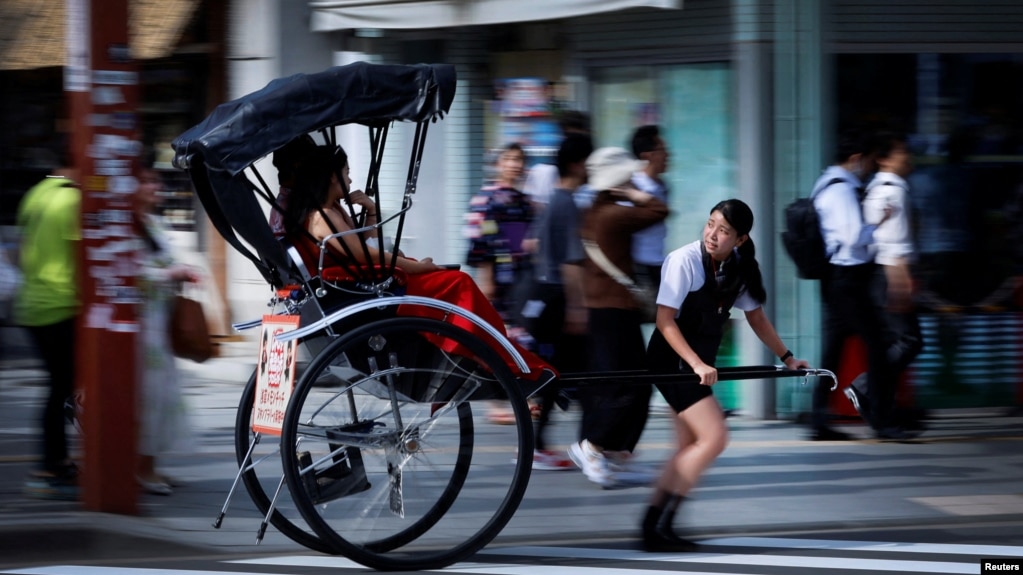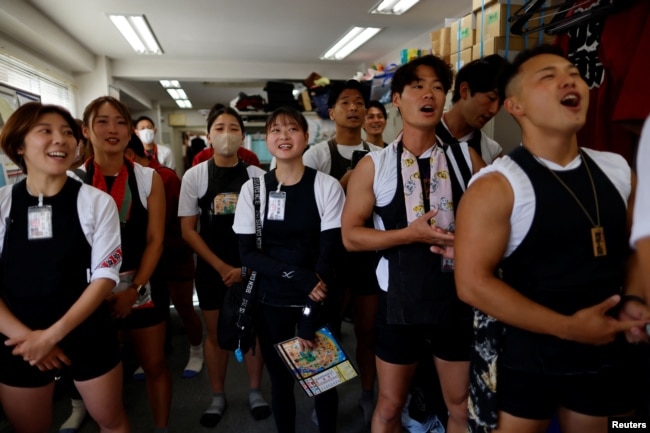Results 1 to 3 of 3
Thread: "Nữ" phu xích lô
-
10-14-2023, 10:43 PM #1
"Nữ" phu xích lô
Khó có thể tưởng tượng được làm phu cyclo là một nghề còn tồn tại trong thế kỷ này hơn nữa là kéo xe chứ không phải đạp. Và hơn thế nữa là phụ nữ làm phu xích lô. Tui ngạc nhiên và ngưỡng mộ những phu xích lô này. Khác với cái nghề nhếch nhác ba cộc ba đồng, nghề kéo xích lô ở Nhật (khu du lịch Tokyo) là một nghề có thu nhập an ổn. Bài báo viết khoảng 6700 Mỹ kim (hơn 1 triệu Yên) tuy nhiên các cô chạy trung bình mỗi ngày 20 cây số và kéo gần đến 250 kí-lô. Nếu là một nam nhân cũng chưa chắc có thể kéo liên tục mỗi ngày 250 kí-lô huống chi là một nữ nhân.
Nghề này là sư tổ của phòng "Năng Vận Động".
Japanese Women Drawn to Rickshaw Pulling

Rickshaw puller Akina Suzuki, 19, drives a rickshaw around Asakusa district in Tokyo, Japan, June 18, 2023. (REUTERS/Issei Kato)
Rickshaw comes from a Japanese word that means “human-powered vehicle.” The vehicle was first used in 19th-century Japan and then in other Asian countries to transport passengers.
Rickshaw pullers are traditionally male. Through social media, some Japanese women are drawn to the profession. And now, they have developed a strong local and international following.
Yuka Akimoto is one of the women who have chosen to pull rickshaws in Tokyo.
“I don’t deny it was extremely hard at the beginning,” Akimoto said, as the rickshaw can weigh up to 250 kg. “I’m not athletic and the cart felt so heavy.”
Now, she says she loves her job and wants to work as long as she is physically able. She wears a small sign that reads: “I don’t want to give up.”
Akimoto joined Tokyo Rickshaw two years ago. The company mainly operates in the Asakusa area, where many people visit. The company says about a third of their 90 pullers are now women. They are seeking more females to work for the company.
“The first girl who joined was cool,” said Tokyo Rickshaw President Ryuta Nishio. “Since we posted videos of her on social media, many girls have followed... and joined us.”
Nishio said he wants to create a place where women feel at ease and can be involved.
Rickshaw pullers wear special, traditional clothing on their feet. The pullers walk or run an average of 20km a day, no matter the weather.
In addition to being physically strong, rickshaw pullers must know a lot about Tokyo. They also need to communicate with visitors who want to see the city.

Tokyo Rikchsaw pullers attend a morning meeting at the office in the Asakusa district, Tokyo, Japan, June 18, 2023. (REUTERS/Issei Kato)
The most popular pullers earn over 1 million yen (about $6,700) a month. That is three times the national average. Tokyo Rickshaw noted that less than 10 percent of all applicants are offered a job.
The pullers actively use social media to increase their popularity. They want people to request them personally and repeat rides.
It was those social media posts that influenced college student Yumeka Sakurai to join Tokyo Rickshaw.
“I’ve watched many videos of women training hard and becoming rickshaw drivers themselves. They gave me confidence that I could do it too if I tried hard,” the 20-year-old said.
Sakurai’s friends and family disapproved of her choice. But after four months of training, she says she feels pleasure pulling passengers in her rickshaw.

Rickshaw puller Akina Suzuki, 19, takes a photo of a family of tourists from Taiwan during her guided tour around the Asakusa district in Tokyo, Japan, June 18, 2023. (REUTERS/Issei Kato)
Shiori Yano is 29 years old. She has been pulling rickshaws for nine years. She balances the demands of the job and her family.
She took a four-year break after having a child. She now works the rickshaw for eight hours a day, hurrying to pick up her daughter from childcare before going home to cook dinner and do housework.
“This job looked flashy from the outside but I’ve had some hard times, including when I was rejected in favor of a male driver,” Yano said. Still, she says she will continue to work because she enjoys it.
Tokyo Rickshaw’s Nishio said sometimes people are not satisfied women are doing such physically demanding work. Female pullers also sometimes face unwanted sexual behaviors or have their knowledge questioned by male riders, he added.
“We treat both male and female pullers completely equally,” Nishio said. “The women say they want to be treated the same as the men, and in fact many of them are way tougher.”
I’m Gena Bennett.
Mariko Katsumura reported this story for Reuters. Gena Bennett adapted it for VOA Learning English.
/* src.: https://learningenglish.voanews.com/...g/7286954.html

 Puck Futin
Puck Futin
-
10-15-2023, 07:10 AM #2
Theo tiếng Hán Việt thì phu là đàn ông còn đàn bà là phụ - “nữ” kéo xe là phụ xích lô.
Muốn đỡ cực thì gắn thêm cái động cơ điện như mấy xe đạp hay xe xì cút tơ, hành khách đỡ thấy ái ngại cho mấy phụ xích lô. Tận nhân lực, tri điện lực.
-
02-06-2024, 03:54 PM #3
Phụ nữ đạp xích lô ở Sài gòn cũng có:


Similar Threads
-
ET phone home ! "Người ngoại tinh" trở thành "minh tinh" (màn ảnh)
By BatNgat in forum Thời Sự Trong NgàyReplies: 4Last Post: 06-26-2021, 01:19 AM -
"KHOÁN THỦ" hay "HOÁN THỦ?"
By Việt Hạo Nhiên__ in forum Ngôn ngữ họcReplies: 3Last Post: 01-05-2016, 08:24 AM -
"Nàng Dae Jang Geum" và "Hậu cung Chân Hoàn truyện"
By Dân in forum Chuyện Linh TinhReplies: 0Last Post: 10-11-2013, 12:58 PM -
- La viết tắt của "People's Republic Of China" (cộng hòa nhân dân Trung Hoa) Hoặc "Made In PRC" cũng
By ngocdam66 in forum Tiếu LâmReplies: 2Last Post: 03-05-2013, 07:44 AM -
Executive Chairman of Google Inc.: Ask Google to remove label "China" and "Nine-Dotted Line" on maps
By Ba Ếch in forum Quê Hương TôiReplies: 1Last Post: 04-13-2012, 12:11 PM






 Reply With Quote
Reply With Quote